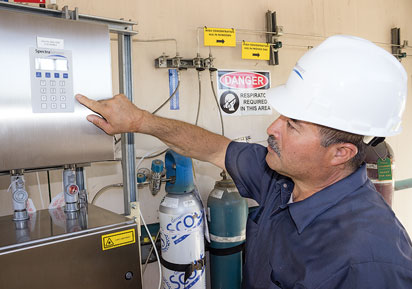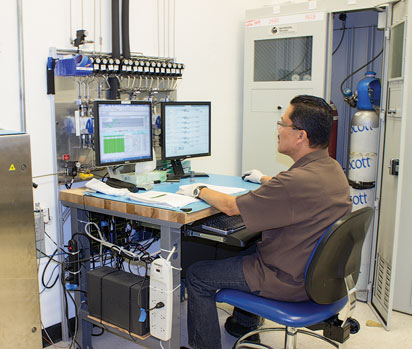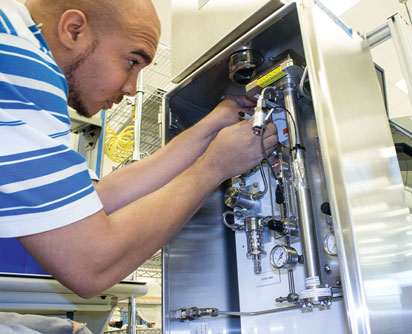Metering and custody transfer
J. Apgar, Contributing Writer, Chino Hills, California
Upstream, gas producers and processors deliver natural gas to fill growing demand for the clean-burning fuel. Downstream, hundreds of miles of pipeline infrastructure deliver the gas to market.
In between, at the points of custody transfer, are multitudes of analyzers ensuring that contaminants, such as hydrogen sulfide (H2S), are low enough to protect the pipelines and the public (Fig. 1). This critical measurement prevents corrosion, which, in the worst case, can lead to pipeline rupture.
 |
|
Fig. 1. At points of custody transfer, analyzers ensure that contaminants are low |
What happens if the gas supplier and user each use a different H2S analyzer? There is a saying in the natural gas industry: “If you have one analyzer, you have a measurement; if you have two analyzers, you have an argument.”
Hunter Brown, a measurement control supervisor for Access Midstream, explains this saying: “Sometimes, you will have a dispute when two different companies are using two different analyzer brands. The readings can be 2 ppm apart, and that can mean a lot if the third party is reading 7 ppm and the supplier is reading 5 ppm; in fact, it can result in a shut-in.”
The reason accuracy is so important is simple—money. Neither the supplier nor the buyer can afford to halt any part of the 70 Bcf of natural gas consumed in the US on a daily basis. If two analyzers show different readings in the same line, who wins the argument? The answer: Whichever party can demonstrate the most accurate analyzer.
The final word. Fortunately, there is a final word in accuracy at the National Institute of Standards and Technology (NIST). If an analyzer is calibrated with highly accurate gas, and that gas can demonstrate NIST traceability, then the argument is over.
“Both calibration and validation are important; if either one is wrong, it’s not going to read right,” says David Bromley, a natural gas measurement coordinator for BP. “If I get that test gas in, and it is reading 3 ppm instead of 4 ppm, the question is, is it the test gas or the analyzer? One of them has to be wrong.”
Increasingly, producers and processors are demanding greater accuracy through NIST traceability, and that has prompted analyzer manufacturers to respond. Originally, analyzer companies simply ordered a calibrated gas bottle from a reliable source and used it to calibrate their analyzers at the factory. Once calibrated, the unit was ready to be used. However, those companies discovered that not all bottles are created equally, and that, historically, the manufacturers were not tracing their standards back to NIST. The companies were encountering a higher degree of uncertainty in the bottles than the manufacturers claimed.
H2S is a notoriously difficult component to blend into a gas mixture if it is to remain stable. That problem becomes progressively worse as concentrations become lower. Anecdotal stories exist about chain-of-custody and monetary-valuation arguments concerning the quantity of H2S in a pipeline, based on unresolved differences in the calibration of H2S analyzers. These differences are brought about by hidden discrepancies in the certified H2S values on different calibration gas cylinders. Concentrations of the gas bottles can be much more variable than end users may realize.
Major commitment. Companies know that it will take major commitments of time and money to build the traceability path back to NIST. However, the reward will be worth it (Fig. 2).
 |
|
Fig. 2. It takes major commitments of time and money to build the traceability |
The H2S concentration needed in the bottles was 4 ppm and 16 ppm, both of which had to be in a matrix gas of methane and nitrogen. Also, everything needed to be NIST traceable. One answer that worked was “dual certification.”
A common industry method to produce H2S mixtures is to dilute H2S down to 4 ppm, analyze it in a lab and then put a certification of approval on it. However, that process has accuracy risks, even if performed to NIST reference standards, because there is no second check of the actual concentration and no indication of long-term stability. The dual-certification process, which uses gravimetric and analytical procedures with full NIST traceability, requires that the two independent methods come to the same result and agree with each other within close statistical boundaries.
First, a cylinder supplier must determine the concentration and the accuracy of the mixture by mass alone, using NIST primary references and stringent statistical methods. Then, the same cylinder must be tested in the laboratory using instruments calibrated with NIST standard reference materials.
When these two independent processes agree with one another, there is high confidence in the certified H2S concentration, and the required unbroken chain of comparisons within the two measurements can be traced all the way back to NIST.
How does NIST know that its values are correct? A three-step process is used that includes worldwide verification.
“When we create primary standards, we design the procedure to develop a suite of standards that define a concentration range that we wish to use to support customers,” says Dr. Franklin Guenther of NIST.
“To verify the primary standards, we analyze the suite on an instrument with a well-defined instrument function, such as gas chromatography, which has a linear function. If all the primary standards fall on the linear response function of the instrument, then we are confident that the standards are self-consistent, and that no blunders have occurred in the filling process. We then analyze the standards against past primary standards, and, if they agree, then we are confident that our standards are historically consistent and that our measurement system has not shifted over time. Our third method of verification is to measure them against other national metrology institutes in a bilateral, or key, comparison.”
The bottom line for everyone in the measurement business is that NIST is the standard, and NIST traceability trumps all debates.
Total measurement system. In the end, what is needed is a total measurement system. If companies are concerned about the H2S content in the pipeline, then all elements of their measurement systems must be optimized. The sampling/conditioning lines, the analyzer and the calibration gas must be free of errors and work together as an integrated system. If companies are not using a total measurement system, then they risk making a less accurate measurement, leaving them susceptible to economic losses.
Bromley agrees. “We need to have repeatability and accuracy in our measurement. If you are measuring 4 ppm, then you need to have repeatability and accuracy. Accuracy is the most important, because I would hate to shut a valve on a company when they are not out of spec. We do get measurement disputes. When we see it go past 4 ppm, we shut the valve down, and the sender might say, ‘we don’t see that over here.’ Then I know they don’t have the type of analyzer we have, and that can give you two different answers.”
The analyzer should be calibrated at the factory using the new, dual-certified, NIST-traceable H2S-calibration standards (Fig. 3). Customers can then validate the unit in the field with a NIST-traceable bottle.
 |
|
Fig. 3. The analyzer is calibrated at the factory using dual-certified, NIST-traceable |
For natural gas suppliers and users, the end of the H2S measurement argument at transfer points in pipelines could finally be in sight. GP
Acknowledgments
The author wishes to acknowledge analyzer manufacturer SpectraSensors and cylinder supplier Air Liquide for their research support for this case study.
John Apgar is a freelance writer based out of Chino Hills, California.




Comments